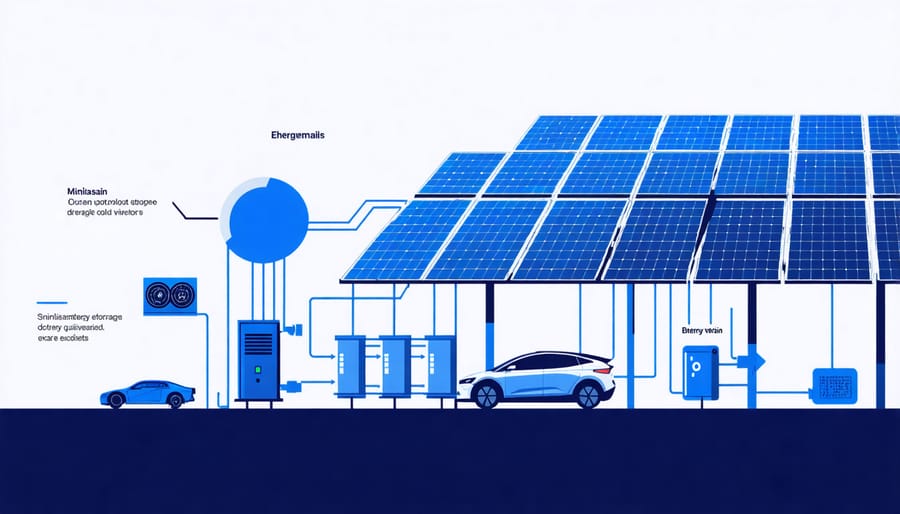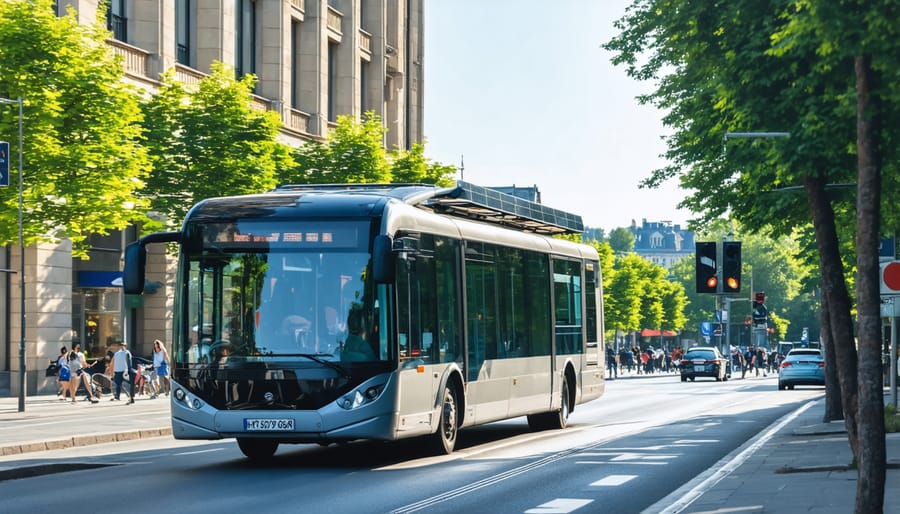Solar-Powered Buses Transform European Public Transit: Here’s How They Work

As cities across Europe race to achieve carbon neutrality, solar-powered buses emerge as a groundbreaking solution transforming public transportation. These innovative vehicles, equipped with advanced photovoltaic panels across their roofs, represent a perfect fusion of sustainable mobility and renewable energy technology. By harnessing solar power to supplement their electric drivetrains, these buses reduce operational costs by up to 30% while eliminating harmful emissions in urban environments. Recent successful deployments in cities like Munich and Amsterdam demonstrate how solar-powered buses not only address environmental concerns but also provide reliable, efficient public transport service—even in regions with varying sunlight conditions. This technological leap forward showcases Europe’s commitment to sustainable urban development, offering a glimpse into the future of clean, quiet, and energy-independent public transportation.
How Solar-Powered Buses Revolutionize Public Transport
Solar Panel Integration Systems
Modern solar-powered buses utilize sophisticated integration systems that seamlessly incorporate photovoltaic panels into the vehicle’s structure. The most common configuration places high-efficiency solar panels across the bus roof, maximising exposure to sunlight while maintaining the vehicle’s aerodynamic profile. These panels are typically lightweight, flexible, and specifically designed to withstand vibrations and varying weather conditions.
The integration system consists of three main components: the solar array, power management unit, and energy storage system. The solar panels connect to smart charge controllers that optimise power collection and distribution. These controllers automatically adjust to changing light conditions and regulate the flow of electricity to either power the bus directly or charge the onboard batteries.
Most European solar bus designs incorporate between 8-12 square metres of solar panels, generating approximately 2-3 kWh of energy during peak sunlight hours. The panels are secured using specialised mounting systems that ensure stability while minimising additional weight. Advanced thermal management systems prevent overheating and maintain optimal panel efficiency, while protective coatings shield the panels from environmental damage and reduce maintenance requirements.

Energy Storage Solutions
At the heart of every solar-powered bus lies a sophisticated energy storage system that ensures reliable operation throughout the day. Modern electric buses typically employ lithium-ion battery packs, strategically positioned underneath the vehicle’s floor to optimize space and weight distribution. These high-capacity batteries, ranging from 250 to 450 kWh, work in tandem with advanced solar charging technology to maximize energy efficiency.
The energy management system (EMS) plays a crucial role in balancing power input from solar panels with the bus’s operational demands. During peak sunlight hours, excess energy is stored for later use, while sophisticated algorithms monitor and regulate power consumption based on factors like route conditions, passenger load, and climate control requirements.
European manufacturers have implemented innovative storage solutions, including temperature-regulated battery compartments and rapid charging capabilities. Some models feature regenerative braking systems that recover kinetic energy during deceleration, further extending the bus’s range. This integrated approach to energy storage ensures consistent performance while maintaining the sustainability benefits that make solar-powered buses an attractive option for public transport systems.

Real-World Performance and Benefits
Environmental Impact
Solar-powered buses represent one of the most impactful sustainable energy solutions in modern public transportation, offering significant environmental benefits. Each solar bus can reduce carbon emissions by approximately 100 tonnes annually compared to conventional diesel buses, contributing substantially to urban air quality improvement.
The environmental impact extends beyond mere emission reduction. Solar buses help decrease noise pollution in city centers, creating more liveable urban spaces. The solar panels utilized in these vehicles are increasingly manufactured using sustainable practices, with many European manufacturers implementing closed-loop recycling programs for end-of-life panels.
In terms of resource efficiency, solar-powered buses reduce dependency on fossil fuels by up to 90%, depending on the specific model and operating conditions. The integration of advanced energy storage systems allows for optimal solar power utilization, minimizing energy waste and maximizing renewable energy usage.
Furthermore, the lifecycle assessment of solar buses shows promising results, with a carbon payback period of approximately 3-4 years. This includes the environmental cost of manufacturing solar panels and batteries. As technology advances and production methods become more efficient, this payback period continues to decrease, making solar buses an increasingly attractive option for sustainable urban mobility.
Operating Cost Advantages
Solar-powered buses offer significant financial advantages through reduced operating costs compared to conventional diesel buses. The most substantial saving comes from fuel expenses, as solar energy provides a free power source once the initial infrastructure is in place. Studies across European cities show that operators can reduce their fuel costs by up to 70% when transitioning to solar-powered buses.
Maintenance costs also decrease considerably due to the simpler mechanical structure of electric drivetrains. With fewer moving parts and no need for regular oil changes or emission system maintenance, solar buses require approximately 40% less maintenance than traditional buses. This translates to reduced downtime and lower labour costs.
The longevity of solar technology further enhances the cost benefits. Modern solar panels typically come with 25-year warranties and can maintain over 80% of their original efficiency throughout this period. While the initial investment may be higher, the return on investment usually occurs within 5-7 years of operation, depending on route intensity and local energy costs.
European transport authorities report additional savings through government incentives and carbon credit schemes. For instance, operators in Germany and France have accessed substantial subsidies for implementing solar-powered bus fleets, further improving the financial feasibility of these sustainable transport solutions.
These combined savings enable transport operators to maintain more competitive ticket prices while increasing service quality and frequency.
European Success Stories
Current Deployments
Several European cities are leading the way in solar-powered bus deployment, demonstrating the technology’s viability in public transportation. In Madrid, Spain, a fleet of 10 solar-assisted buses has been operating since 2021, featuring roof-mounted panels that power auxiliary systems and reduce fuel consumption by up to 15%. The success of this initiative has prompted the city to expand its solar bus network to 30 vehicles by 2024.
Dresden, Germany, launched an innovative pilot program in 2022 with five fully solar-powered buses operating on shorter urban routes. The buses utilize advanced energy storage systems and smart charging infrastructure, enabling them to operate efficiently even during cloudy weather conditions.
In the Netherlands, Utrecht’s public transport authority has integrated solar panels into bus shelter roofs, creating a complementary charging network for their electric bus fleet. This system generates enough power to support both the buses’ auxiliary systems and the shelters’ lighting and information displays.
Notable implementations can also be found in Copenhagen, Denmark, where solar-powered buses are part of the city’s comprehensive sustainable transport strategy. The municipality reports a significant reduction in operational costs and maintenance requirements compared to conventional buses.

Future Expansion Plans
The future of solar-powered buses looks exceptionally promising, with numerous European cities planning to expand their sustainable transport networks. By 2025, major urban centers including Paris, Berlin, and Amsterdam aim to convert at least 30% of their public bus fleets to solar-electric hybrid systems. These initiatives align perfectly with Europe’s solar potential and climate objectives.
Innovative developments in solar panel efficiency and energy storage systems are driving the next generation of solar buses. Manufacturers are working on advanced photovoltaic materials that can increase energy capture by up to 25%, while reducing panel weight by 40%. Additionally, smart grid integration projects are being developed to enable buses to contribute excess energy back to local power networks during off-peak hours.
Several pilot programs are scheduled to launch in 2024, testing new features such as transparent solar windows and regenerative braking systems that maximize energy recovery. These technological advancements, combined with decreasing production costs, are expected to make solar-powered buses increasingly accessible to smaller cities and rural transport networks.
The European Union has already earmarked €2.5 billion for sustainable public transport initiatives through 2027, with a significant portion dedicated to solar bus infrastructure development.
Implementation Considerations
Implementing solar-powered buses requires careful consideration of several key factors to ensure successful integration into existing public transport systems. Initial infrastructure investment includes installing charging stations with solar panels at bus depots and key route locations. These stations must be strategically positioned to maximize solar exposure while fitting within urban planning constraints.
Fleet operators need to consider the local climate and seasonal variations in solar intensity when planning routes and charging schedules. In northern European regions, supplementary charging solutions may be necessary during winter months when daylight hours are limited. The integration of smart energy management systems helps optimize power consumption and route planning based on available solar resources.
Maintenance requirements differ from conventional buses, necessitating specialized training for technical staff. This includes expertise in both electric drive systems and solar technology maintenance. Cities must also develop contingency plans for backup power sources during extended periods of limited sunlight.
Cost considerations extend beyond the initial vehicle purchase to include infrastructure development, staff training, and system maintenance. However, many European municipalities have found success by implementing pilot programs before full-scale deployment, allowing for gradual adaptation of both infrastructure and operations.
For optimal implementation, cities should conduct thorough feasibility studies that account for local solar radiation levels, route requirements, and existing transport infrastructure. This approach ensures sustainable integration while maximizing the environmental and economic benefits of solar-powered bus systems.
Solar-powered buses represent a transformative force in European public transportation, offering a sustainable solution to urban mobility challenges. With successful pilot programs across cities like Madrid, Amsterdam, and Dresden demonstrating their viability, these eco-friendly vehicles are poised to become a cornerstone of future transit systems. The technology continues to evolve, with improvements in solar panel efficiency and battery storage making these buses increasingly practical for diverse climate conditions. As European cities commit to carbon neutrality goals, solar-powered buses are expected to play a crucial role in reducing transport emissions while providing reliable public service. The integration of these vehicles into existing fleet networks, combined with growing infrastructure support and public acceptance, signals a bright future for solar mobility in European urban transit. This innovation not only addresses environmental concerns but also offers long-term economic benefits through reduced operational costs and energy independence.
Leave a Reply